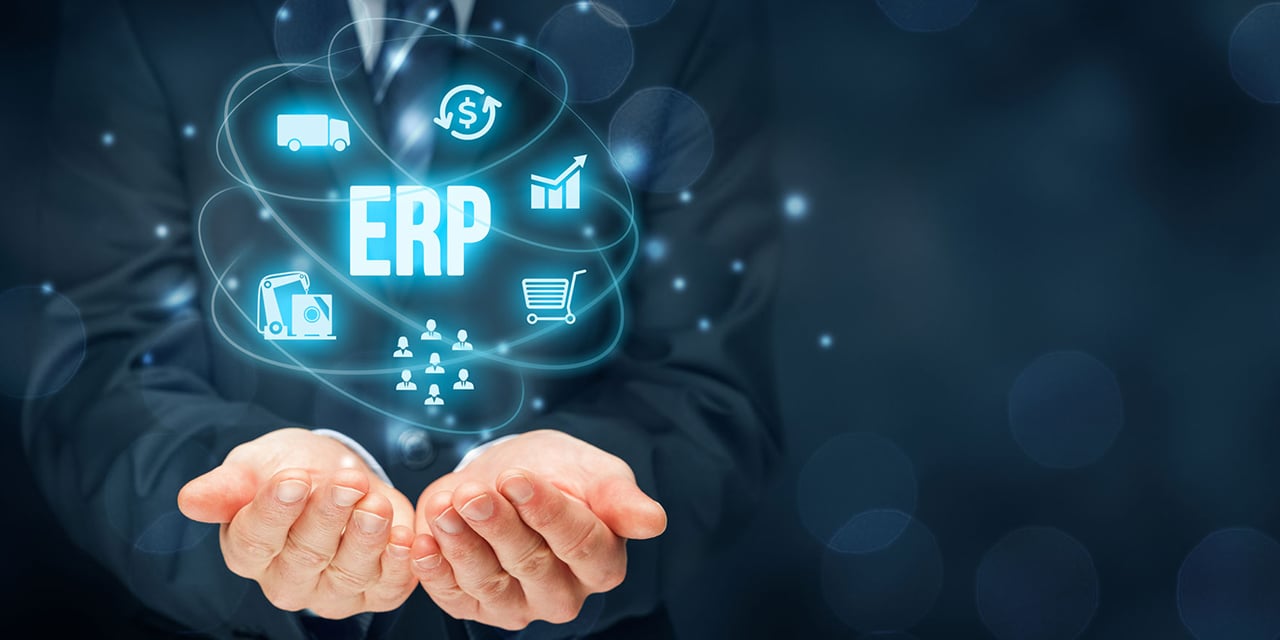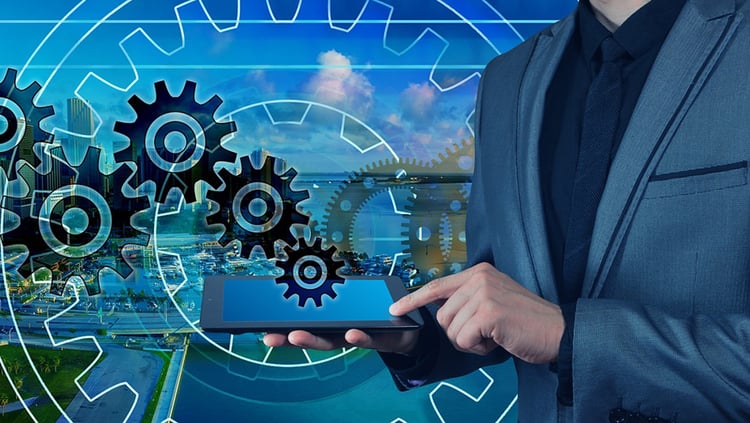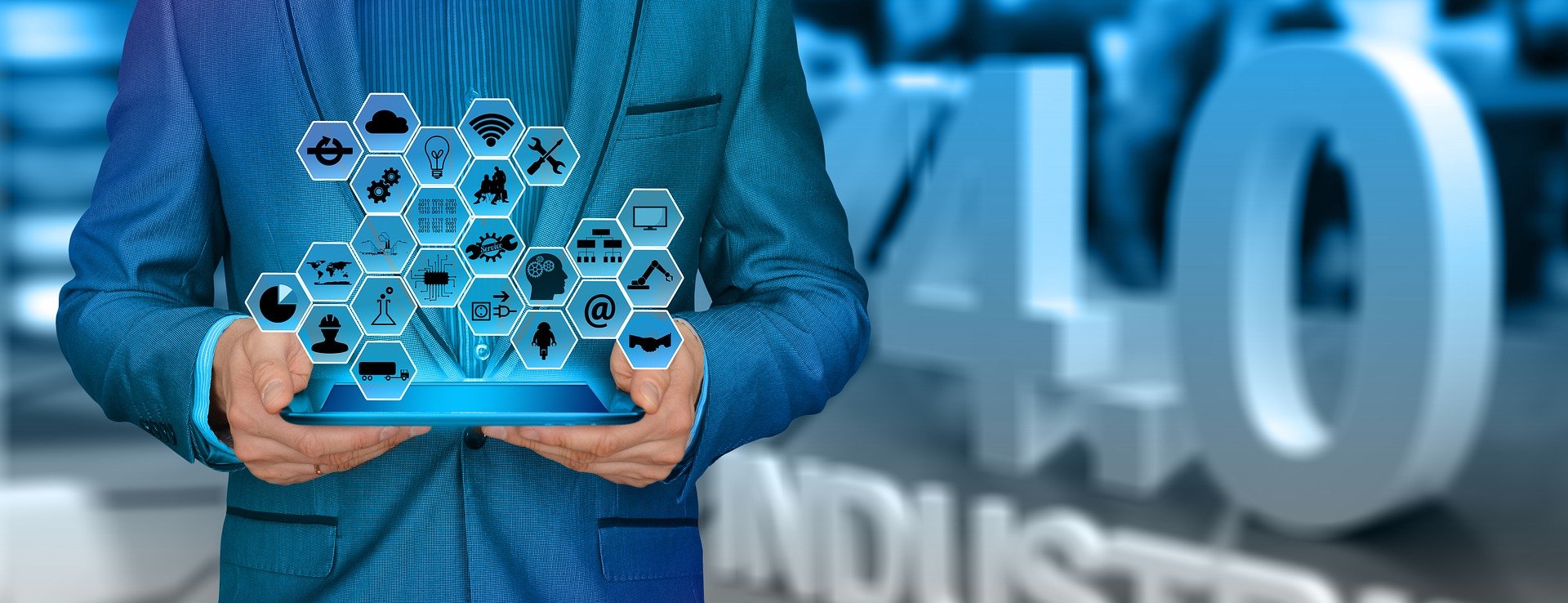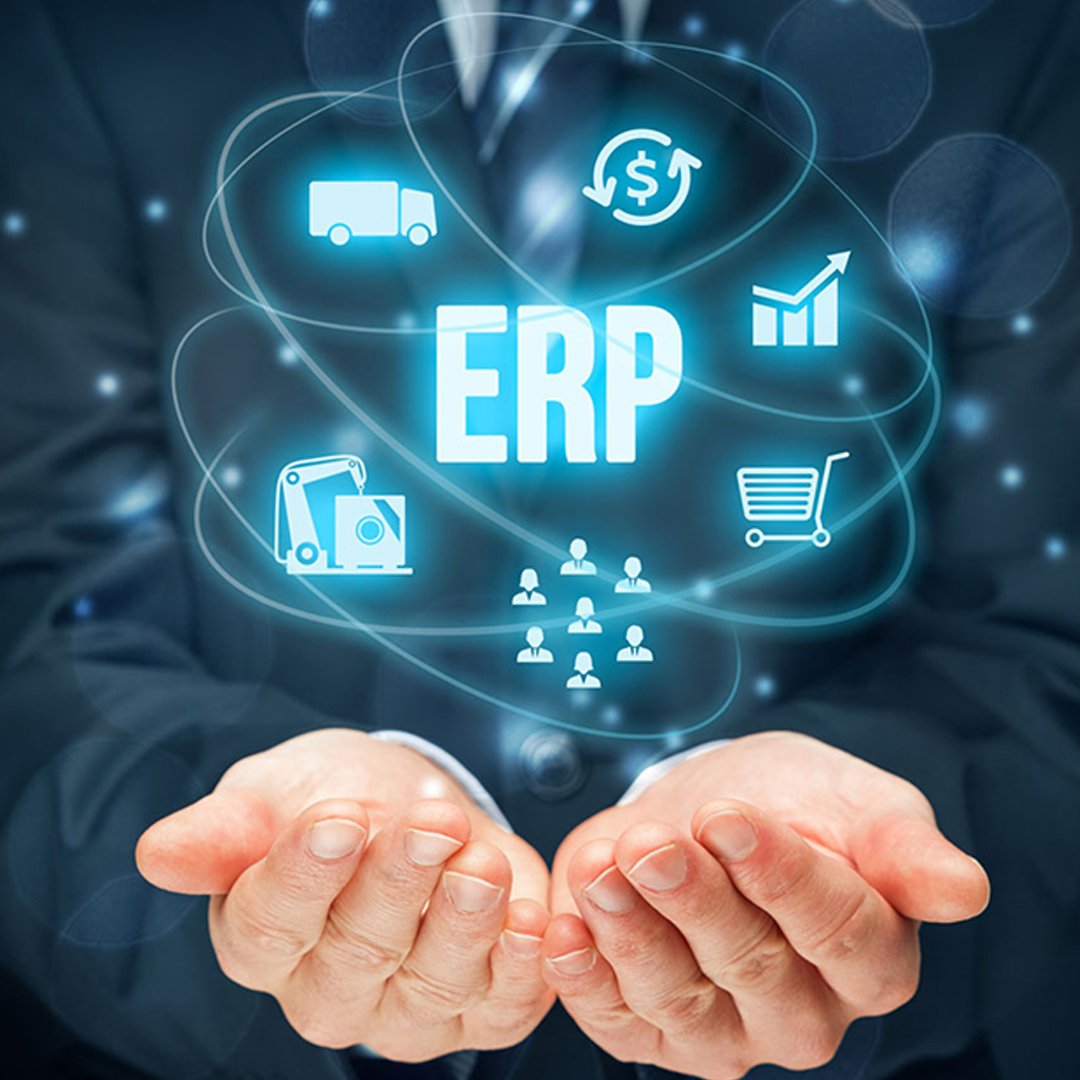In today’s world, huge amounts of information circulate instantly. In distribution centres, during major spikes in activity, stocks have to be increased to keep up with sales volumes and meet delivery pledges. Which means logistics professionals must be able to rely on a high-performance information system. This is where ERP (Enterprise Resource Planning) comes in.
From production to after-sales service, ERP offers a permanent overview of logistics flows and stocks. Let Scallog guide you through this leading management software tool.
What is ERP?
ERP stands for Enterprise Resource Planning.
Basically it’s a shared database used to track and manage information in a company.
ERP software comprises various moduleswhich are autonomous but mutually compatible.
Each module is attached to a single database. The various modules contain programs and functionalities for performing specific tasks.
The information and the ERP software itself are stored in the database.
This database is therefore the pivot point of every operation performed in the software package.
There is a large catalogue of ERP tools on the market. As a collaborative management mode, ERP covers the central and primarily financial functions of the company (acquisitions, finance, sales etc.).

So where di ERP come from? War!
During the Second World War, the need to manage military resources in an unprecedentedly vast theatre of operations required a means of keeping track of deployments of personnel and of matériel and supplies.
However, ERP in its modern form is derived from MRP (Material Requirement Planning).
MRP is a fairly recent tool, designed around 1960 by the American engineer Joseph Orlicky.
A combination of software and database, MRP schedules production based on resources (people, raw materials, machines and time), dates and stock requirements.
Two factors have contributed to the uptake of modern ERP in today’s enterprises:
- First, many “home made” enterprise information systems were not advanced enough to survive the year 2000 watershed and the emergence of new technologies. ERP was largely developed between 1995 and 2000.
- The changeover to the euro came almost immediately afterwards, forcing companies using “home made” information systems to turn to ERP. Many organizations, in fact, were unable to adapt quickly to the new currency.
Forged in a military context, ERP gradually moved to the civilian world and now assists enterprises by providing insight into their entire structure.
In enterprises, ERP facilitates the flow of information, eliminating redundant tasks and inconsistencies between different departments.
Before ERP, book inventory did not always tally with actual stock.
Such misalignments had to be corrected, which slowed down production and hampered the operation of the entire enterprise.
ERP addresses this type of problem in two ways (or more):
- all computer applications run on a single database (in modules)
- a workflow engine determines the tasks involved in a process and oversees their accomplishment in all system modules that require it.
According to software consulting firm Teknowlogy (formerly CXP) every ERP must:
- Emanate from one and the same provider
- Ensure the uniqueness of the information guaranteed by the availability of the entire database structure from each module, even individually
- Support real-time updates to information in all affected modules
- Provide audit trails for ensuring full track and trace of management operations
- Cover a single management function (or workflow), or the enterprise’s entire information system.
What are ERP modules?
While the collaborative management model of ERP primarily addresses accounting aspects, the various modules cover all the operations specific to other areas of the enterprise.
The most common modules are dedicated to:
- finance: these contain information relating to cash flow, financing, accounting, investments etc.
- sales: information relating to sales, such as orders, products, prices
- human resources: salaries, overtime, taxes etc. This kind of module collects information relating to personnel management
- CRM: (Customer Relationship Management): This module oversees the enterprise's relations with its customers and analyses needs, expectations, and customer history.
One module is dedicated to logistics.
ERP: logistics module
Logistics associated with the sale of a product are fundamental to the an enterprise’s business, ERP addresses the following domains:

- production: who plans production activities such as manufacturing control and acquisition of materials, your work orders etc.
- sales: including functionalities relating to the sale, delivery and billing of products and to all pre-sales tasks.
- purchasing and supplies: covering processes ranging from suppliers of materials to manufacturing and sales operations (also useful for evaluating suppliers, managing purchases, and monitoring invoices.)
-
warehouse management: this software includes stock control, evaluation and management; it also tracks order invoicing and centralizes the information used during logistics processes.
SAP, one of the world’s leading ERP developers, offers the following logistics modules:
- Material Management (MM) : a logistics module that manages purchases and stocks.
- Production Planning (PP) : a production management module that managesbills of materials, their compliance, and product lines from a production supervision perspective.
- Sales and Distribution (SD) : a sales administration module that managesRFQs, bids, contracts, customer orders, shipments and deliveries, returns, billing, and the sales information system
In logistics, ERP software helps optimize ROI and facilitates business management.
What exactly is ERP for?
Automating the management of an organization is the primary goal of every ERP system.
As an enterprise grows, the actors driving this growth enrich the initial information base with different elements from their spheres of competence.
ERP therefore allows any piece of information to be entered only once and made available to the various departments of the organization.
Not only can all departments have access to the same level of information, but they can automatically assign tasks or review requests.
ERP software gives a real-time snapshot of what the company owns and what’s happening in it.
This information helps optimize the management of inventory, stock, workflows, and more.
B2B / B2C sales management solution for orders, stocks, e-commerce, payroll and accounting management: with ERP, every business process draws on different management functions.
That’s why ERP software can be seen as the “backbone” of an organization.
Why choose ERP?
ERP increases the safety and productivity of processes by managing the complexities involved in:
- connecting functions via the use of common data
- the standardization of processes and data
- the transformation of transaction data into useful information: entering a sale in the ERP solution automatically generates a double-entry ledger record in the sales journal, with automatic calculation of VAT..

ERP offers significant benefits for the smooth running of a company:
- It collects and analyses all data related to the supply chain, then detects patterns so operations can be organized better.
- Working in conjunction with other enterprise software, it automates numerous tasks and updates the data in each one
- It helps in decision making and simplifies reporting
- All logistics flows are traceable and archived to maintain full control over every operation, past and present
With these capabilities, and real-time data too, organizations can make reasoned, well-grounded decisions.
By providing the right responses to the different needs of the organization, ERP reduces costs.
For an ERP solution to meet your logistics needs, you first have to:
- define your needs
- choose scalable software
- make sure the software is easy to use, to minimize training time
Depending on what an organization needs, many parameters can be taken into account when choosing an ERP solution (optional add-on modules, data security, capacity for international use etc.)
ERP in logistics
As we’ve seen, ERP is used in logistics for management of inventory, stock, and product storage locations. But it’s easy to get best of breed, WMS and ERP software mixed up.
So what’s the difference between ERP and best of breed solutions?
Specializing in a single domain, a best of breed solution itself consists of other interconnected software.
Each of the software components of a best of breed solution is considered to be among the best in its class.
However, unlike ERP, best ofbreed software may contain software from various vendors.
Best of breed solutions cover their field more completely.
They may address business-specific areas such as legal regulations.
Less cumbersome and easier to grasp than ERP, best of breed applications aim for efficient operation and ergonomics.
There are ERP and best-of-breed solutions for the logistics market, each model with its own strategy.
Henri Seroux, director of Manhattan Associates, a company specializing in software for the supply chain sector, observes:
Best-of-breed solutions have led the way in responding to market expectations, and are well ahead of ERP in their ability to meet highly targeted needs in short implementation times
Jean-Marie Vigroux, CEO of ERP provider Sylob, maintains:
Although best-of-breed solutions are designed for companies with significant needs in terms of interfacing with their various tools and technical platforms, SMEs will be able to meet their needs more easily using the SCM (Supply Chain Management) module of their ERP solution
In fact, from the SCM point of view, the principal challenges are compatibility and good integration between ERP and logistics modules.
Henri Seroux adds:
Most SMEs will prefer to scale up their ERP with specific add-ons rather than invest in highly targeted, and often more expensive, best of breed solutions
What’s the difference between ERP and WMS?
ERP is an enterprise-wide solution; WMS (Warehouse Management System) is not.
Unlike ERP, WMS aims only to optimize an enterprise’s supply chain operations.
As its name suggests, warehouse management software is designed to improve the management of a warehouse and the stock it processes.
WMS is therefore a solution which:
- provides real-time information on stock
- optimizes the flow of goods
- indicates the personnel numbers required in the warehouse
All of which help reduce and optimize costs.
While the logistics capabilities of ERP may look similar to those of a Warehouse Management System, WMS offers more advanced options than ERP.
As its primary function is to control and determine the order processing sequence, ERP may fall short in its logistics management capabilities.
WMS software, like an ERP logistics module, executes the orders given to it.
In this sense, WMS alone is not enough. Therefore WMS is always coupled to an ERP solution and cannot be used instead of it.
Many medium-sized companies use WMS as an integral part of their ERP solutions.
Other enterprises running ERP add a specific WMS function to their supply chain management (SCM) solution.

Some companies do have a stand-alone WMS, but even in these cases the WMS dialogues with ERP.
Grasping the difference between these two tools allows them to be used effectively.
ERP: What are the benefits for logistics?
There are as many types of ERP as there are categories of business, so the software package delivers real added value.
Your organization may already have an ERP that meets expectations. You just need to define the criteria you want it to have.
Oracle, SAGE, SAP et CEGID are the leading companies in the ERP market.
However, before choosing an ERP system, it’s a good idea to make sure:
- the software is aligned with your organization's objectives (customer satisfaction, cost synergies, and shorter processing times)
- and is able to interact with existing management software.
Note that when it comes to supply chain management, the recommended solution is based much more on the nature of the business than its size.
As Pierre Yves Minarro, Deputy CEO of SCALLOG, observes:
It’s not so much the size of a company that makes ERP an interesting proposition or not. If my company employs 1000 people and produces millions of units, then I’m definitely going to be interested in ERP. On the other hand, if I can double my turnover by making two yachts a year, I probably don’t need ERP.
What future for ERP?
The last 5 years have seen the emergence of On Demand solutions.
These solutions require ERP to operate in SAAS (Software as a Service) mode, which is the operating mode for certain Cloud-based software) and to be accessible online via a monthly subscription format.
The duration of the right of use varies according to the commitment. We're talking here about software rental.
An ERP solution working in SAAS mode is managed directly by the service providers and is no longer hosted on the client’s premises but in an information centre.
SAP and Oracle, for example, sell virtually all of their solutions this way.
To relieve enterprises of the burden of managing their information systems and hardware, service providers now prefer to host most of the systems they sell in centres located in France or elsewhere.
Business intelligence tools have been evolving steadily for more than 20 years now.
ERP leads the way in this dynamic! The gradual disappearance of physical dialogue and the rise in competition are pushing companies to react.
Accounting systems must be put in place.
While a few companies still manage their workflows over their own systems, these are increasingly scarce as ERP becomes a generalized tool.
In 2019, about 50% of companies revised their ERP budgets upward.
This increase reflects the fact that for many companies, ERP is now a necessity.




Laisser nous votre commentaire